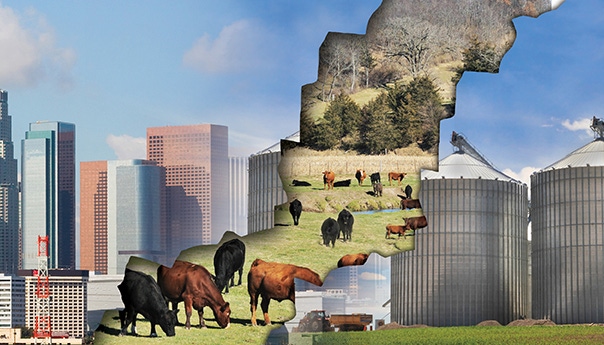Ignorance Is Ag's Biggest Challenge When Connecting With Consumers
The disconnect between farmers and consumers makes it easy for folks with an agenda to concoct messages they know will have the most effective emotional impact, themselves knowing the fiction and intent underlying such messages.
October 25, 2013

Editor’s Note: “Ignorance is Ag's Biggest Challenge” is the second of a three-part series previously written by Wes. Although the series wasn’t written spcifically for the veterinary community, the information is extremely relevant as the beef industry moves into reshaping itself to feed a growing planet.
“The United States today has more bus drivers than it has farmers.”
That single sentence, written by Chrystia Freeland in a worth-your-time column, “The Triumph of the Family Farm” in the July-August 2012 issue of The Atlantic magazine, offers perfect perspective for what is arguably the key challenge cattle and agriculture producers face going forward.
Less than 2 percent of the U.S. workforce is involved directly in agricultural production today — 40 percent was in 1900, according to USDA’s Economic Research Service (ERS). Most Americans today are so far removed, generationally, from direct agricultural experience that they have no reason to question the glaring falsehoods spouted by activist groups and well-meaning urban ecologists.
It would be like someone telling me that infrared ultra-draconian frequencies emitted by today’s power stations cause cancer. I know little about the science associated with electronics, electricity or anything else that might emit a wave; there’s no such thing as infrared ultra-draconian frequencies, by the way. But I know what a power station is and I know what power lines look like. I’m busy. I won’t check the veracity of the claim, but at least subconsciously, I’ll be wary of anything that looks like it’s associated with a power station. That’s not fair. It’s not even rational. It’s reality.
This ignorance—far different than stupidity—makes it easy for folks with an agenda to concoct messages they know will have the most effective emotional impact, themselves knowing the fiction and intent underlying such messages.
• Buy local, it’s good for the environment.
• Modern, intensive cattle operations are damaging to the environment, compared to more, smaller operations.
• Methane emissions from livestock have more impact on the carbon footprint than the entire transportation industry.
• Growth hormones used in beef production are unsafe.
• Antibiotics used in livestock production are causing antibiotic resistance in humans.
The list goes on.
These all come from the same barrel as ultra-draconian frequencies.
If you know nothing about the industry or the specifics mentioned, false statements like these have a ring of truth about them.
The Spiral Downward
Perhaps more vexing is the impact of this generational disconnect on folks who don’t have a bone to pick with agriculture one way or the other, but these folks are charged with all kinds of things that directly impact agricultural producers.
“One factor driving today’s regulatory environment that impacts animal agriculture—covering the gamut from animal housing and subtherapeutic antimicrobial usage to environment and labor—is pressure applied by consumers,” say authors of Living in a World of Decreasing Resources & Increasing Regulation: How to Advance Animal Agriculture. This white paper revolves around information synthesized from the 2012 Annual Conference of the National Institute for Animal Agriculture (NIAA).
“Unfortunately, a majority of today’s consumers are at least three generations removed from agriculture, are not literate about where food comes from and how it is produced, and tend to have high expectations,” say the authors. “Because these consumers don’t know the people who produce the product, they are driving regulations from a basis of non-trust rather than a basis of trust. The result does not benefit consumers or animal agriculture.”
More specifically, authors of the white paper explain that consumers are calling law makers with concerns about environmental, food safety and rural quality-of-life issues, rather than how to make agriculture more productive. The latter is what helped transform agriculture in the 20th century.
“Today’s societal interest in agricultural research is more complex and less obvious,” say the white paper authors. “The United States went from a largely rural population—where most people were employed directly in farming—to one where only 2 percent of the population are farmers. Moreover, changing consumer demands and new environmental and natural resource problems all affect the role and priorities for public agricultural research.”
The result is what the authors describe as a negative spiral:
• “Consumers turn to elected officials who, like them, are often also disconnected from animal agriculture;
• Elected officials respond to the needs of their constituents and set up regulations designed around accountability and safety;
• Implementation of regulations increase taxes for consumers who then have even higher expectations for accountability;
• Producers push back because the cost of regulations makes their long-term sustainability tenuous;
• The negative spiral continues as constituents want more regulation and those in animal agriculture want less regulation so it can be sustainable.”
“While both consumers and those in food animal production want safe, affordable food produced by individuals who care about animal welfare, well-being and the environment, this common ground is shrinking due to the negative spiral,” the authors say.
The Future is Research
As the common ground shrinks, so does the funding essential for public agricultural research. Ponder for a moment where the cattle business would be today without the intensive research conducted by land grant universities, and the practical outcome of that research delivered to producers via extension.
“Constraints in the world’s ability to feed all its people include land availability, water supply, technology challenges, climate, energy availability and cost, food waste and losses, food safety and government policy. These constraints, therefore, put the onus on animal agriculture to increase efficiency,” explain authors of the NIAA white paper.
After all, agriculture’s massive increase in production with less labor and fewer inputs has had plenty to do with new technology and adoption.
“By 2050, global agricultural demand is projected to grow by 70-100 percent due to population growth, energy demands, and higher incomes in developing countries,” according to Public Agricultural Research Spending and Future U.S. Agricultural Productivity Growth: Scenarios for 2010-2050,published by ERS. “Meeting this demand with existing agricultural resources will require raising global agricultural total factor productivity (TFP) by a similar level. Maintaining the U.S. contribution to global food supply would also require a similar rise in U.S. agricultural TFP.”
Subscribe now to Cow-Calf Weekly to get the latest industry research and information in your inbox every Friday!
With that in mind, ERS analysts explain that TFP growth in U.S. agriculture is dependent on long term investment in public agricultural research. TFP growth for U.S. agriculture has averaged about 1.5 percent over the last 50 years, they say.
“ERS simulations indicate that if U.S. public agricultural R&D spending remains constant (in nominal terms) until 2050, the annual rate of agricultural TFP growth will fall to under 0.75 percent and U.S. agricultural output will increase only 40 percent by 2050. Under this scenario, raising output beyond this level would require bringing more land, labor, capital, materials, and other resources into production,” say the ERS analysts. “Additional public agricultural R&D spending would raise U.S. agricultural productivity and output growth. Raising R&D spending by 3.73 percent annually (offsetting the historical rate of inflation in research costs) would increase U.S. agricultural output by 73 percent by 2050. Raising R&D spending by 4.73 percent per year (1 percent annual growth in inflation-adjusted spending) would increase output by 83 percent by 2050.”
So, ignorance or its solution will determine cattle and agricultural producers’ ability to harness increased efficiency and feed the world’s growing, more economically prosperous population.
“Implications of a decline in the long term growth rate in U.S. agricultural productivity are significant for both the United States and the world,” say the ERS analysts. “Slower productivity growth will likely cause agricultural prices to rise, which would reduce global economic welfare and raise poverty in urban areas and among food-deficit rural households, especially in developing countries. Rising prices would also increase pressure to expand agricultural cropland at home and abroad and input use on cropland would likely intensify. Such agricultural resource expansion and intensification could come with significant environmental costs, such as further impairment of soil and water quality, loss of biodiversity, and increased emissions of greenhouse gases. Finally, agricultural exports may also decline as U.S. farmers lose competitiveness in international markets.”
“While new technology will require heavily investing in agricultural research and development, today’s federal government is lessening its financial support of agricultural research and development that addresses efficiency-improving technology related to practices, products and genetics,” say authors of the NIAA white paper.
Ignorance, indeed, comes at a high price.
You might also like:
Photo Gallery: Cattle Death Toll Rises As Atlas Blizzard Recovery Continues
Cargill Closure Announcement, How Much Can The Industry Afford?
65 Photos That Celebrate Cowgirls & Cattlewomen
Ranchers Will Prevail After Winter Storm Atlas Devastates Cattle Herd
3 Most Important Goals For Bunk Breaking Calves
About the Author(s)
You May Also Like




.png?width=300&auto=webp&quality=80&disable=upscale)
